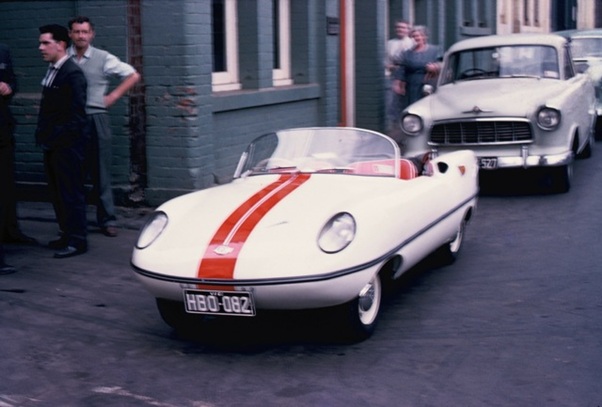
A Goggomobil Dart parked outside the laneway to the Finlay Brothers workshop entrance - in Little Londsdale Street, Melbourne in 1959.
Photograph by John Boucher. Courtesy of Howard Knox.
The following recollections relating to cars in the Finlay Brothers’ workshops are excerpts from Keith Gales’ unpublished memoirs – Keith worked at Finlay Brothers from 1948 until 1960.
Keith has been very generous in allowing the use of parts of these memoirs, which allow us to see the working life of Finlay Brothers during the post-war years:
Keith recalls the Morgan cars sold by Bri-Law Motors – an agency taken over by Finlay Brothers in around 1956:
“About 1/3 of Finlay’s showroom was rented out to Bricars, they were the agents for the three wheel Morgan car, it had a vee twin engine out front with two front wheels and one wheel at the rear.”1
In the late 1950’s, probably as a result of slowing motorcycle sales, Finlay Brothers took on the dealerships for several other makes of cars, with the Standard car being one of the first:
“Standard cars - [The Head Mechanic] did a factory course and the workshop was altered at great expense so as to get cars in the rear workshop building from the back lane. We were to be the closest Standard agent to the city and they were a very good car. We had the Standard 8 and the Standard 10 Cadet and the Vanguard. The new Vanguard Sportsman came out at that time, all good cars…”2
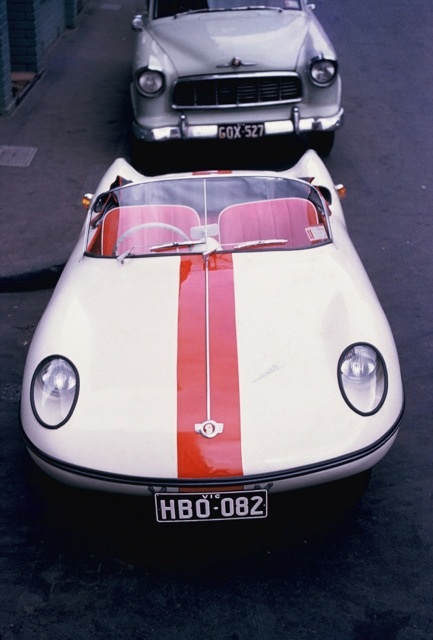
A Goggomobil Dart parked outside the laneway to the
Finlay Brothers workshop entrance - in Little Londsdale
Street, Melbourne in 1959.
Photograph by John Boucher. Courtesy of Howard Knox. | Finlay Brothers also began selling the Goggomobil:
“[Another mechanic] and I could see possibilities here, Goggo’s were all metric, in those days mechanics had to supply their own tools, also supply and clean their own overalls. We had never had to use metric tools up until then. [He] and I went in to the office to [the Workshop Manager] to get an order to buy a set of metric tools to be taken out of our wages; Finlay’s were good that way.
This meant we had a good chance of being the ones working on the Goggo’s.
The first Goggo’s were metal bodies but Buckle Motors in Sydney built fibreglass bodies for them.
They sold for just over £600 the [Volkswagon] Beetle at that time was just over £900, the Holden about £1000.”3
“I did get the job of working on the Goggo’s which was good; they were an amazing little car.” 4
“…nothing accelerated like a Goggo, you could burn everyone off at the lights and they were certainly fun to drive. When we entered the Goggo sedan in a motorkhana it cleaned up all makes of cars.”5
“They were coming down from Sydney at a great rate on semi’s and we had to unload them without any equipment in Elizabeth Street. About six of us had to lift the cars from the top level of the semi by hand, if we had dropped them it could have easily killed us. There were pictures of us in the paper on one occasion. A crowd of onlookers used to watch the operation, I don’t know where the parking men were, the truck was always double parked.
Eventually they were taken to South Melbourne and unloaded, all we had to do then was go and pick them up.”6
“When the cars were sold we had to service them as per the book. …The little rear engine had two sets of points for the two cylinders and one side of the engine had to be dropped to do the job, it was a tedious job to get your head in to see what you were doing.
For the first few months we had no jack, one person used to lift the front of the car up and another had to climb under to grease the front end.”7
“Will Mahoney, a comedian, came over from America where he had lived, to do a show at Her Majesty’s Theatre. …Finlay’s met him when he arrived and presented him with a bright red Goggo to use on the stage, they got a lot of publicity out of that on TV and in the papers.”8
“One lady in Toorak used to keep her Goggo in her lounge room. That was photographed and reported in the Herald newspaper one night and even on TV. I had several service calls to her place… It was certainly unusual going into someone’s lounge room to do a service call.”9
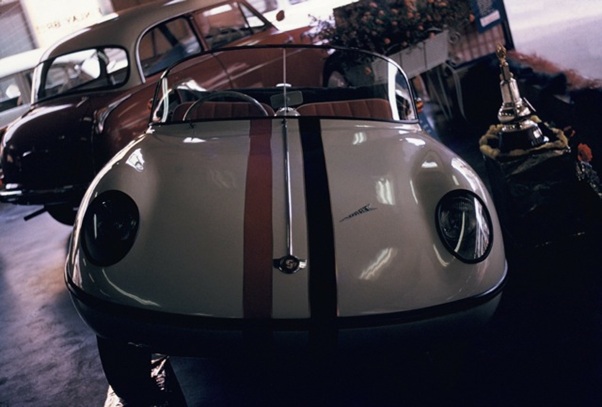
Above & below photographs: Thought to be the actual
Goggomobil Dart that won the Hill Climb in the Golden
Fleece Autokhana in 1959, with trophies, on display in
the Finlay Brothers' showroom.
Photograph by John Boucher. Courtesy of Howard Knox.
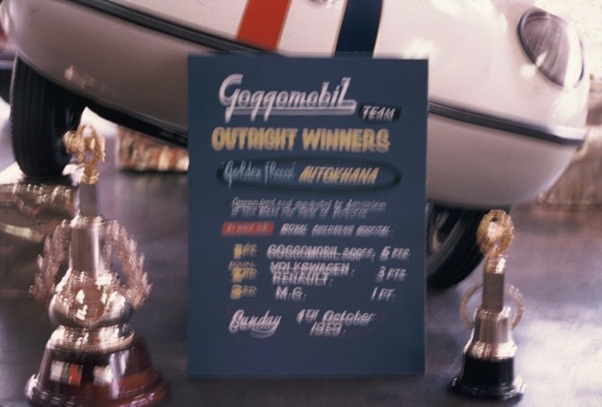
Photograph by John Boucher. Courtesy of Howard Knox.
| And a model known as the Goggomobil Dart made an appearance:
“The Goggomobil Dart – a soft top sports car and built on the Goggo platform – was a spectacular design for its day and made by Bill Buckle, a racing driver and car dealer in Syney, and they sold like hot cakes.
…The Dart was tricky to get in and out of. The Dart didn’t have doors, you just climbed over the side.”10
Goggomobils assembled by Bill Buckle in Sydney had a fibreglass body, compared with the German metal bodied version. This led to challenges for the mechanics in repairing the vehicles:
“…Fibreglass was new at the time and I had to walk all over town to find someone that supplied the material, then I had to experiment how to fix it. I had to mix the resin and allow it to cure, file it off, and then get the car up in the lift to the top floor for Vic Bognor to paint it. The process took us nearly all day waiting for the fibreglass resin to cure then file it off and have it spray painted…
Vic Bognor was very busy also as a lot of buyers wanted their cars painted a special colour and Vic did a beautiful job of repainting the new cars. There were some nice colours too.”11
“Finlay’s had a big and very impressive stand at the Melbourne Motor Show. They always did things in a big way. It featured rolls and rolls of woven fibreglass all spray painted royal blue. The display was fantastic and they had a good range of cars but because it became known that you could pick the Goggo up by hand from the front bumper, and the people were coming in and picking them up, it tore the fibreglass away from where the bumper bolted on and I had to go to the Motor Show early before it opened for the day and fix them.”12
“We started to get the occasional smashed cars and if the owners hadn’t picked all of the parts off the road they were very hard to fix, we had no moulds. By now the repair work got too much for just [one other mechanic] and I and some others had to start doing fibreglass body repair work”13
Finlay Brothers were involved in the Victorian assembly of the Lloyd car:
“Finlay’s opened a workshop in South Melbourne for the car repairs and servicing and also built an assembly line... The car staff moved down there…
The offices were down the centre of the factory building with the assembly line down one side and the repairs down the other.”14
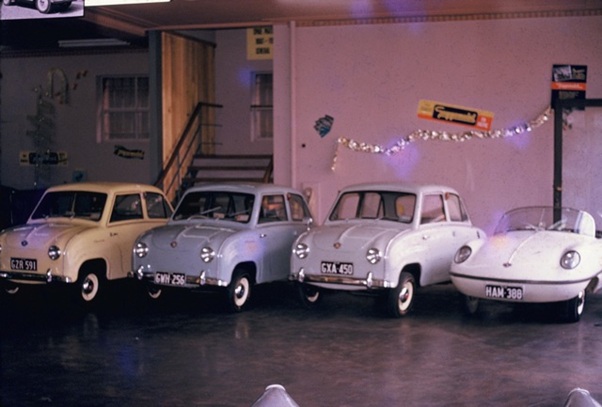
Goggomobil sedans and a Goggomobil Dart (on right) in the rear of the Finlay Brothers showrom. Elizabeth Street is directly behind the photographer. The stairs lead to the Spare Parts Department and offices on the first floor, and a salesman's office is seen at the back right of the Dart.
Photograph by John Boucher. Courtesy of Howard Knox. |
Some car sales and repairs began to take place from one of Finlay Brothers’ suburban premises:
“I hadn’t been working at South Melbourne for many months when I was asked if I’d like to work at a new branch that was opening up at Ringwood with [the gentleman who had been Head Mechanic at the Workshop]…
In 1960 Finlay’s opened Finlay Brothers Ringwood.
[The gentleman who had been Head Mechanic] was in charge of the workshop side of things and I was the worker, it suited me fine as it was only about 3 miles from home.
We had a couple of large adjoining steel sheds where I did the repairs…
We had a large modern showroom for the new... [cars and] scooters etc, and a large second hand yard in the front of the building..
The workshop could be very cold and [the other employee] brought from home a primus stove and ran that all day. He always had a bucket of water on it to humidify the air.
At lunch time, [he] and I would cook jaffles on my gas camping stove, we did live well there.”15
“Finlay Brothers Ringwood closed operations in 1961 perhaps their lease was up and they returned to Melbourne.”16
The late 1950’s also marked the slowing of the motorcycle market, with Finlay Brothers eventually taken over by another firm in 1961:
“…the motorcycle sales that had been the backbone of the business had stopped selling by the late 50’s as people could now afford to buy cars.”17
“Mr Bert drove me into the city one day and tried to get me to stay on but I couldn’t see [myself] driving to work in the city again so I decided to leave Finlay’s after 14 years….
Motorcycles have made a remarkable recovery, in fact they only went out of favour for about ten years. They are now sold mainly for fun, [but] when I started they were used for transport because not many people could afford cars.
Cars eventually became more readily available [till] nearly everyone had one.”18
After finishing work as a mechanic at Finlay Brothers, Keith Gales went on to work in several different industries, and ran his own Volkswagen business for about fifteen years. In his retirement, (among other activities) he builds caravans.
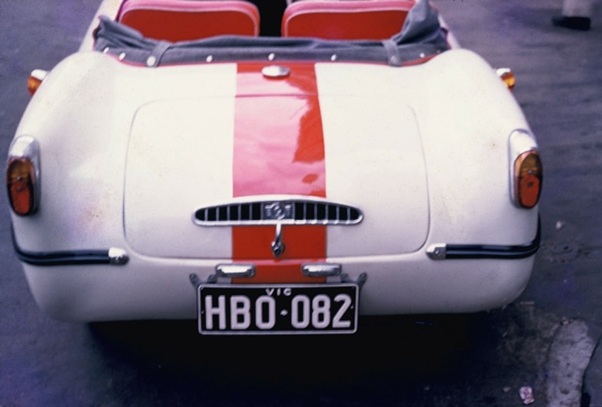
A Goggomobil Dart parked outside the laneway to the Finlay Brothers workshop entrance - in Little Londsdale Street, Melbourne in 1959.
Photograph by John Boucher. Courtesy of Howard Knox.
References:
1. Keith Gales, Unpublished memoirs (2010), p 10 of Chapter 2.
2. Keith Gales, Unpublished memoirs (2010), p 21 of Chapter 2.
3. Keith Gales, Unpublished memoirs (2010), p 22 of Chapter 2.
4. Keith Gales, Unpublished memoirs (2010), pp 22-23 of Chapter 2.
5. Keith Gales, Unpublished memoirs (2010), p 24 of Chapter 2.
6. See note 4 above.
7. Keith Gales, Unpublished memoirs (2010), p 23 of Chapter 2.
8. See note 7 above.
9. See note 5 above.
10. See note 5 above.
11. See note 7 above.
12. See note 7 above
13. See note 5 above.
14. Keith Gales, Unpublished memoirs (2010), pp 26-27 of Chapter 2.
15. Keith Gales, Unpublished memoirs (2010), p 27 of Chapter 2.
16. Keith Gales, Unpublished memoirs (2010), p 29 of Chapter 2.
17. Keith Gales, Unpublished memoirs (2010), p2 of Chapter 2.
18. See note 16 above. |